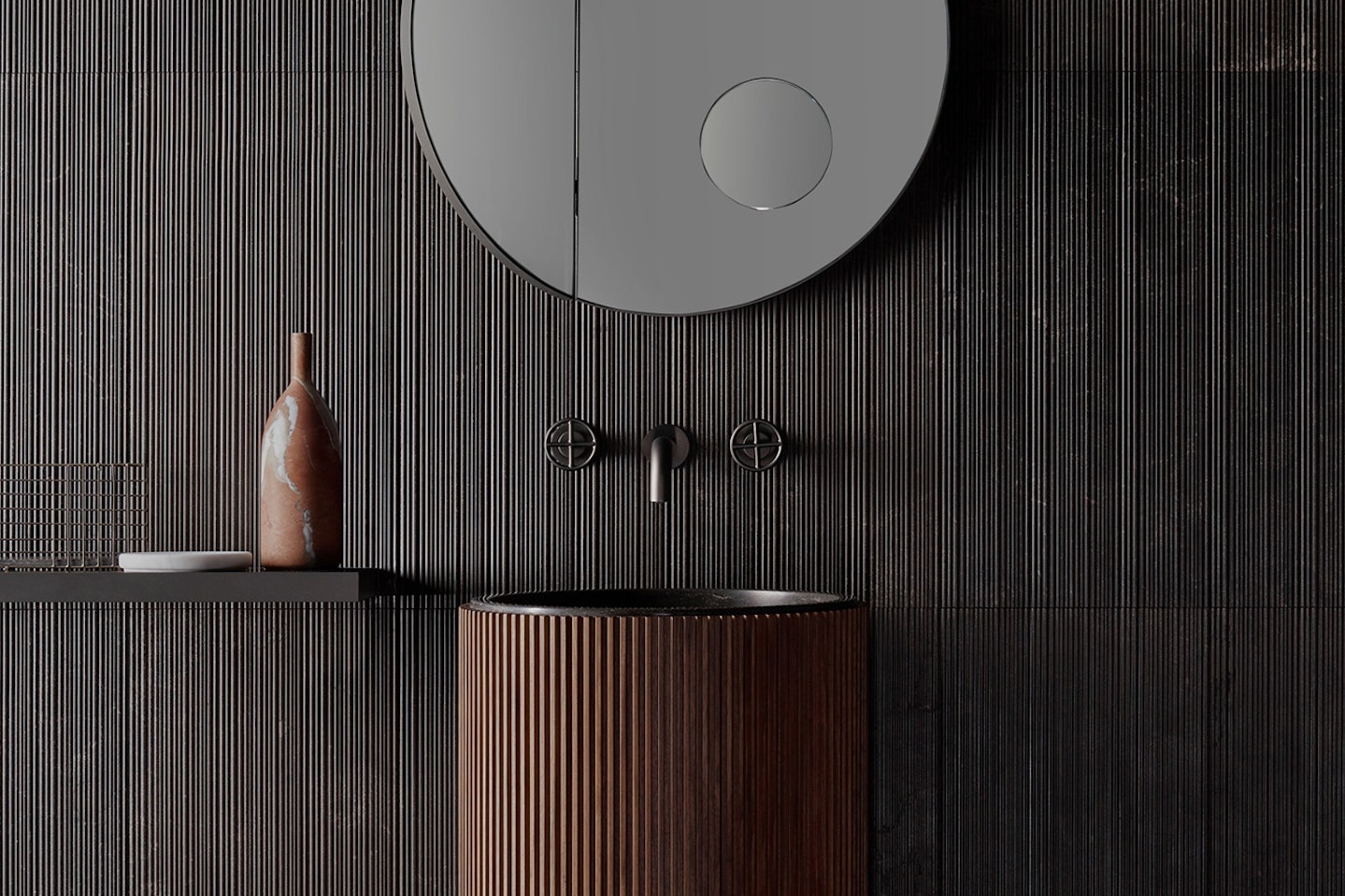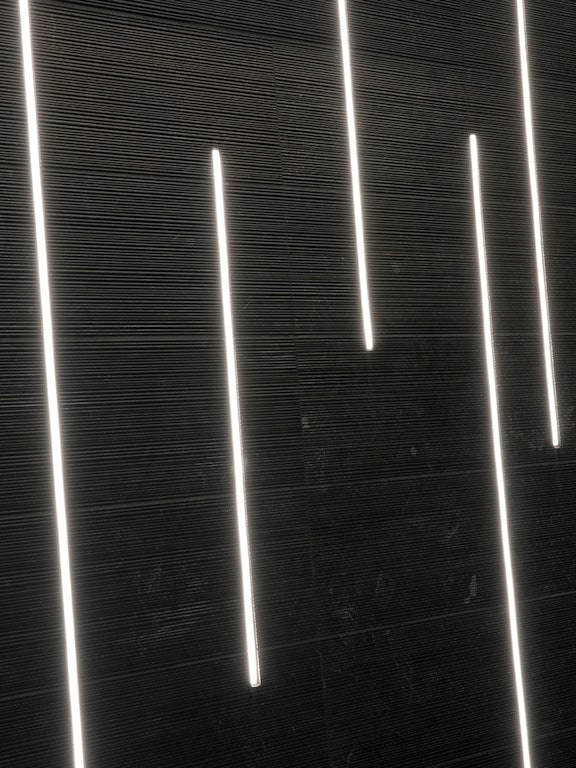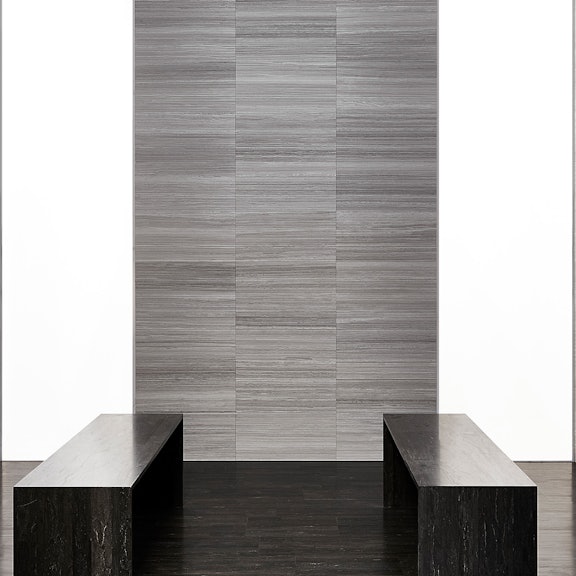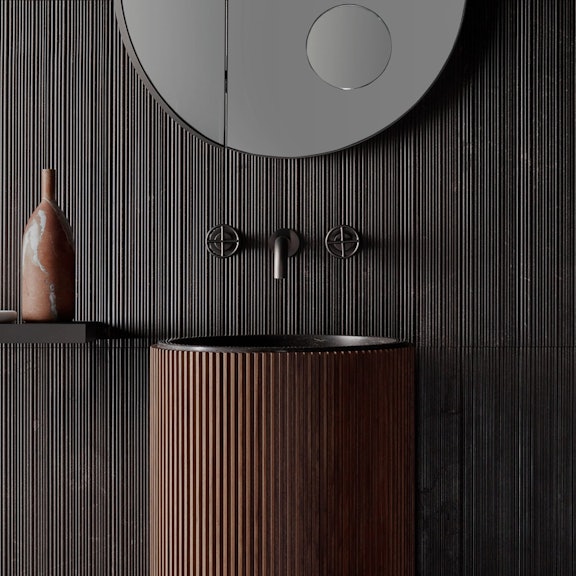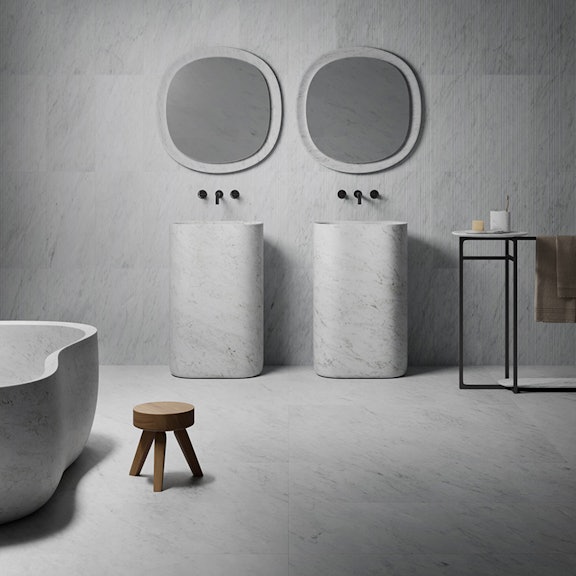Bamboo: the elegance of minimalism in natural stone
03.2022
Bamboo will please your mind and soul with its simple and clean lines and shapes
Minimalist design, natural stone, elegant aesthetic - introducing Bamboo
As one of our most popular and enduring textures, you may already know Bamboo, and, like many others, appreciate its understated, elegant design. Invented by our CEO Gabriele Salvatori in 2003, it draws inspiration from minimalist design cues and is suitable for use both internally and externally. A true globetrotter, you can find it in locations around the world, from New York’s Olympic Tower and Miraval Living residential complexes to the Sheraton Hotel in Stockholm, Louis Vuitton in Tokyo and many other illustrious addresses.
With such credentials, Bamboo deserves a more in-depth look, so let’s find out a bit more about it, including how it came to be invented (clue: get your chopsticks ready!).
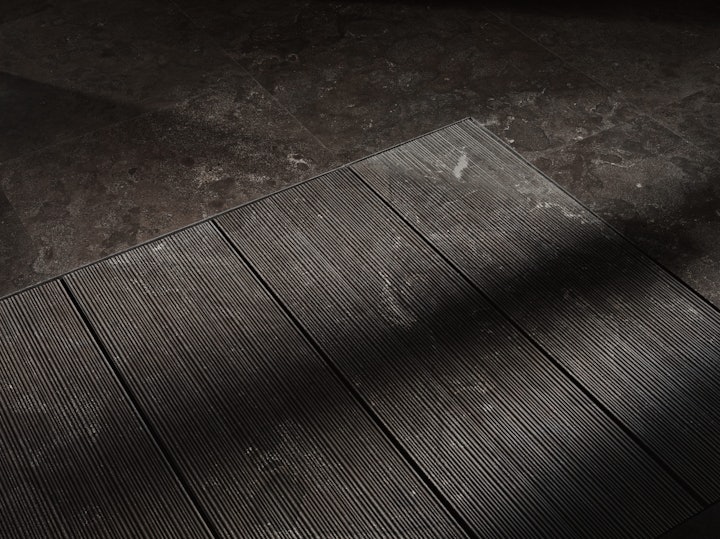
What is Bamboo?
Let’s start with the basics. Bamboo is a texture in a choice of six natural stones, fashioned to evoke the clean, fluid lines of the Orient. It involves a level of precision engineering that is rarely seen in the stone sector, with each tile perfectly calibrated so that it lines up and creates the famous “zero joint” whereby no space is left between tiles.
The result is a harmonious continuity that makes Bamboo an elegant and very easy-on-the-eye design element, particularly on walls, although its grooved surface gives it non-slip properties that make it ideal for wet areas, for example the bathroom or even around a swimming pool. In fact, we offer it as an option in our range of Filo shower trays for that very reason.

The story of Bamboo
Since he was a young boy Gabriele Salvatori, today our CEO, has been involved in the company his grandfather started in 1946. By the late Nineties, he was working closely with his father Alfredo, having already made his mark by starting to focus on innovation. At the time, the stone industry was still very much focused on blocks and slabs, but Gabriele wanted to increase the design aspect, and during his international travels, he was always on the lookout for inspiration and new ideas.
In 2002, he found himself in a Japanese restaurant in New York and started looking closely at the placemat which was made – you’ve guessed it – from bamboo. He loved the organic texture and clean lines, and was so inspired that as soon as he returned to Tuscany, he and Alfredo set about designing a machine which could produce the same effect in natural stone. The following year, Bamboo was launched.
Today, Bamboo is one of our most popular textures, but it was a slow burner at the beginning, as the market hadn’t yet fully embraced the concept of minimalism in design. After all, it was still only a handful of years since John Pawson’s groundbreaking Calvin Klein flagship store had opened on Madison Avenue to gasps of wonder and disbelief. Before long, however, things definitely changed as the glorious simplicity of Asian design became more widely appreciated, with Bamboo becoming an incredible success.

The technical side of things
As we wrote above, Bamboo’s versatility and the fact that it can be used for both interiors and exteriors, means it has been used in all sorts of projects, from the Olympic Tower in New York to Louis Vuitton in Tokyo, as well as, more recently, Manhattan’s high-profile 130 William Street residential complex designed by renowned architect Sir David Adjaye.
One of the things that makes it so widely appreciated and chosen by noted interior designers and architects the world over is its fluidity and the fact that the joins between tiles are almost invisible. This is a key aspect of Bamboo and something we spent a lot of time perfecting. Generally, in tiles you see the joins, but we understood that if we managed to leave the joint in a “shadow” (in the valleys between the ridges), it would be hidden, creating a wonderfully seamless ripple effect.
Easy to say, but not so easy to execute because every tile has to be calibrated extremely precisely and this is not common practice in the stone industry. In fact, we had to adopt tolerance levels more suited to high-precision engineering.
That aside, there are plenty of other fascinating things to discover about Bamboo and how to optimise its use:
• The stones it’s available in
• Tile dimensions
• How lighting plays its part
• How it’s laid
With no further ado, let’s take a look at each in a little more detail.

Stones
Bamboo is available in six types of natural stone, covering a palette of neutral colours ranging from the cool white of Bianco Carrara, moving through various shades of creams and greys until we reach the dark brown of Pietra d’Avola. Those stones are:
• Bianco Carrara
• Crema d’Orcia Select
• Grigio Versilia
• Silk Georgette®
• Pietra d’Avola
• Light Travertine
Each stone has its own particular characteristics, for example Grigio Versilia and Bianco Carrara, which are both marbles, are highly resistant in terms of wear and tear, abrasion and temperature, making them extremely versatile and able to be used in pretty much any type of environment.
Pietra d’Avola is a limestone but shares the same characteristics, however, it’s good to know that over time, its dark tones may gradually become slightly less intense.
When it comes to Light Travertine, Silk Georgette® and Crema d’Orcia, all three have a medium level of resistance to abrasions. In other words, this means that they are slightly more susceptible to surface scratching, however, with the ridged texture of Bamboo, these will tend to be less visible.
Last, but not least, when it comes to any type of natural stone, we should remember just how long-lasting it is. The Colosseum, after all, was built of Travertine around two thousand years ago and it’s still holding up pretty well!
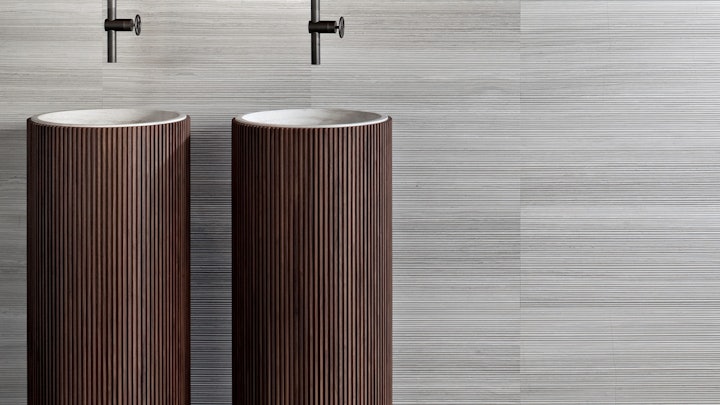
Tile size
The tiles come in dimensions of 293 x 586 mm and are 10 mm thick, apart from the Travertine version which has a thickness of 12 mm. We also provide honed tiles in the same dimensions so that if you are, for example, using Bamboo on the wall and honed on the floor, the joints will line up perfectly both vertically and horizontally, emphasising the fluidity that is such an integral feature of Bamboo’s aesthetic.
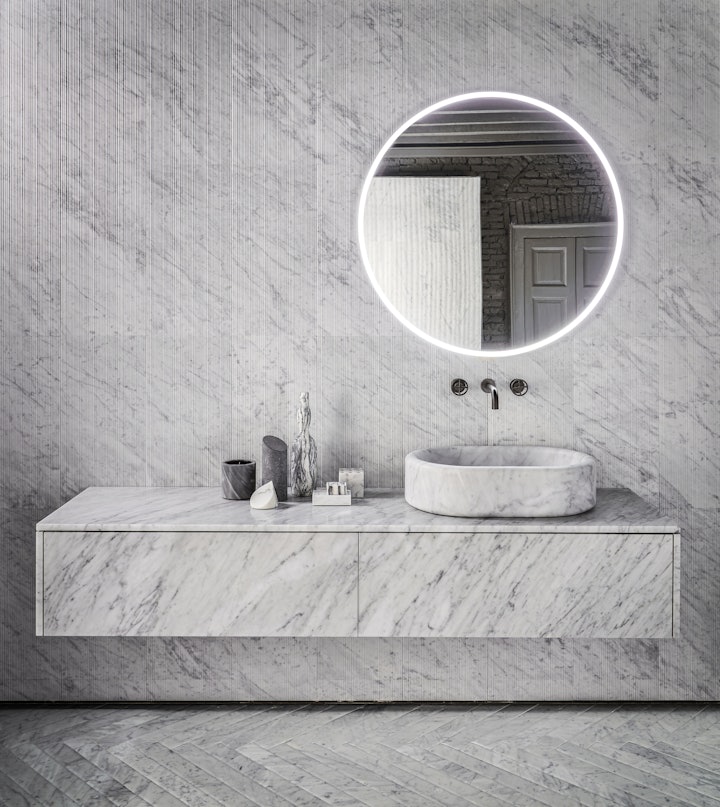
A word about lighting
Lighting is a very important aspect when using Bamboo, as it brings the texture alive and adds a gorgeous additional dimension. As such, it is something that should be considered quite early on in the design process. Will there be natural light? Adjustable lighting? Light coming from the sides or from above?
The key thing is that whatever light there is, should wash across the surface of the Bamboo, as the play of light and shadow will help camouflage the joints. And, depending on where that light comes from, this will also determine whether the lines should run vertically or horizontally. There’s detailed advice available in our installation guide, and it’s definitely worth following, so that you optimise the beauty and fluidity of the texture.
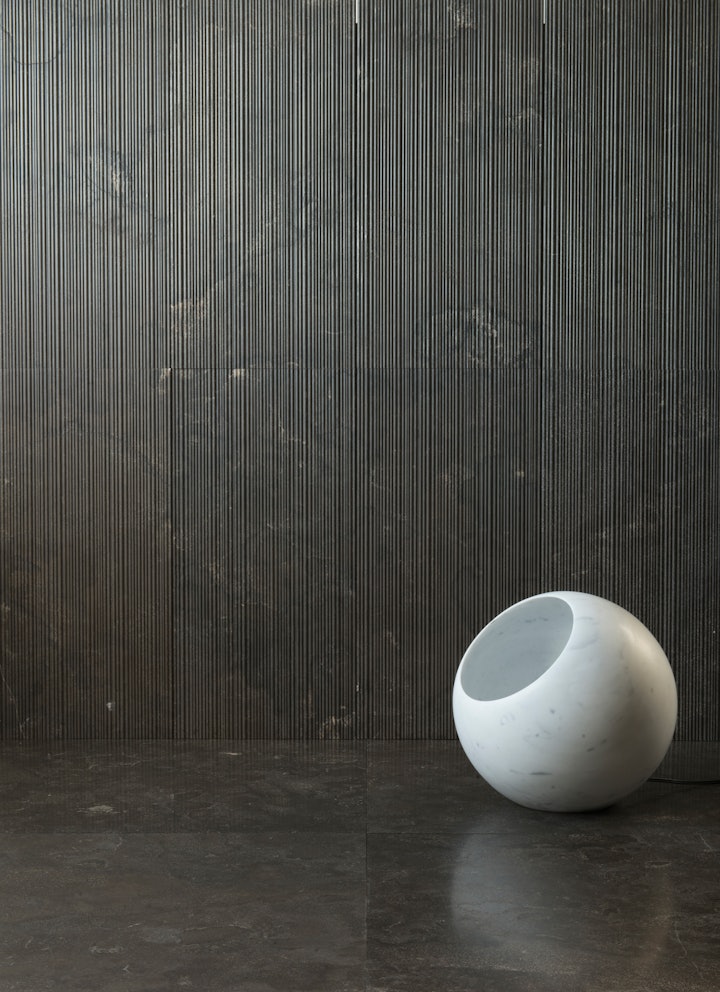
Laying direction
Bamboo can be laid horizontally or vertically, depending on a combination of personal preference and how it works with the light, as described above. If you are installing it in a shower or on an external wall, we’d recommend that you lay it so that the lines run vertically as this will help the water flow freely in a downwards direction and minimise any build-up of limescale.
We know we keep saying it, but the fluidity really is what sets Bamboo apart, and it’s the attention to detail, not just in the way each tile is designed, but also how they are laid, that makes the difference. The measurements are so precise that when they are laid beside each other, there is no visible joint so if they don’t line up perfectly, you simply rotate the tile 180 degrees and voilà, there’s that famous seamless effect!
So, that’s our introduction to the world of Bamboo done. If you are looking for a versatile, elegant solution in natural stone, that is much loved by interior designers and architects around the globe for its beautiful clean lines and fluidity (there’s that word again!), why not browse our website for plenty of inspiring ideas of how it can be used?
